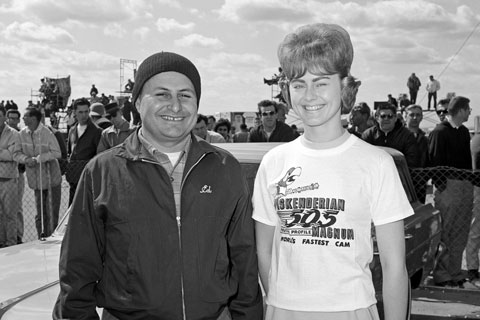SEMA News—November 2013
HERITAGE
By Drew Hardin
Photo Courtesy Petersen Archives
Crane’s First SEMA Show
 The dapper man in the bow tie is Harvey Crane. He’s talking about his camshafts and valvetrain components to dealers in the Crane Engineering Company booth at the very first SEMA Show (though it wasn’t called that at the time).
The dapper man in the bow tie is Harvey Crane. He’s talking about his camshafts and valvetrain components to dealers in the Crane Engineering Company booth at the very first SEMA Show (though it wasn’t called that at the time).
In January 1967, some 100 aftermarket companies set up booths in the concrete aisles of Dodger Stadium’s Club Level for what was then called just “the trade show.” Crane, one of SEMA’s earliest members, brought his wares from his company’s headquarters in Hallandale, Florida, and demonstrated them using a “hand-operated engine simulator,” according to a story in Petersen Publishing Company’s Hot Rod Industry News.
Crane, who passed away in May at age 81, was among the pioneers of the automotive performance aftermarket. The son of a machinist and fabricator, he ground his first camshaft—for a Henderson motorcycle engine to be used in a midget racer—in 1946 when he was just 15 years old. He spent his teen years turning Ford flathead V8s into race engines, and he started Crane Engineering in 1953 using a corner of his father’s machine shop as his workspace. The company was incorporated in 1963, the year SEMA was formed.
While southern racers knew early on how much power Crane could coax out of an engine, he started garnering national attention in 1961, when Pete Robinson won Top Eliminator at the NHRA Nationals running a Crane camshaft in his blown Chevy mill. Crane would go on to patent the design for mechanical roller tappets; design the first rocker arms to feature roller tips, needle-bearing fulcrums and gold anodizing; introduce the concept of a cam with extra-high lift (0.669-in. lift); and debut the first budget-priced camshafts—his Fireball cams—at the 1972 SEMA Show.
Crane’s pioneering achievements weren’t limited to making drag cars, NASCAR competitors and others go faster. In 1965, he revolutionized the ability to compare camshafts by developing the technique of measuring duration “at 50”—between .050-in. of lifter rise and .050-in. before the lifter closed. He was also what we now call an early adopter of computer technology, drafting his first computerized camshaft design in 1967 using a timeshare computer and a program sent from Michigan through telephone lines.
Crane was forced out of his namesake company in 1989 but went on to form a consulting company and a cam school, where he taught more than 100 engine builders the secrets of making power. He was inducted into the SEMA Hall of Fame in 1981 and was elected a Fellow of the Society of Automotive Engineers in 1988.






